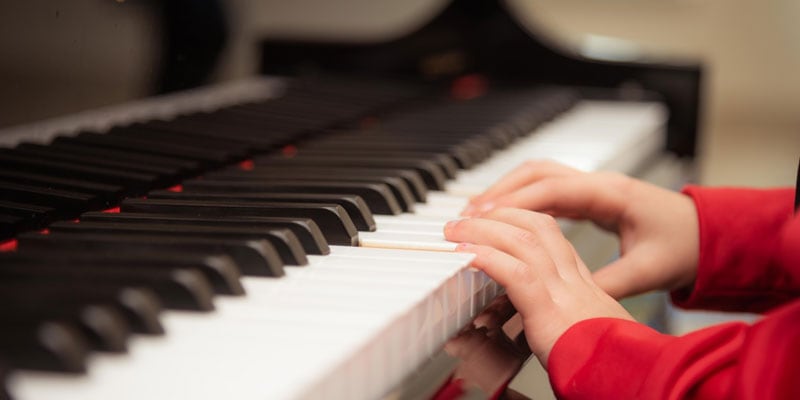There are different types of pianos, and each one has its own unique sound. If you’re looking for a piano that’ll produce a deep, reverberating tone, then you should consider a grand piano. On the other hand, if you’re on a tighter budget, or need something that’s more portable, there are other options available.
In this blog post, we’ll explore the different types of pianos and their features. So, whether you’re an experienced musician or just starting out, we hope you find this information helpful!
What Are the Different Types of Pianos That Exist Today?
Upright Piano
Generally, pop and rock music is played on an upright piano. This type of piano is compact in design, but sturdy. The strings are hit with a wooden stick, which produce a very strong sound.
Most travel pianos for this genre have electric keys that allow the player to move the volume up or down while playing. The height of a piano can vary in size, from 36 inches to 48 inches.
Upright pianos are rarely used when recording music or playing classical music because this type of player does not have the same volume level as the other types of pianos. In addition, upright pianos do not have a pedal.
Grand Piano
In order for the strings of the piano to produce sound, they must be hit by two wooden blades called hammers. The result is a loud, clear, and crisp sound. Grand pianos are the preferred instrument for most types of music and recordings because they can be heard clearly in large spaces.
Usually, grand pianos have three pedals:
The soft pedal is called the sostenuto pedal. This pedal allows the pianist to press down on a key or chord and have that sound continue to ring until another chord is played. This is very helpful in classical songs when extra emphasis is needed in certain places.
The damper pedal, also known as the sustain pedal, lifts the dampers off the strings. This allows for all of the chords to ring out, without having to play continuously. Without this pedal, most chords would not have any resonance behind them.
The third pedal is the una corda pedal or “one string” pedal. It’s basically an alternative damper with a smaller surface area. This pedal allows for a softer sound.
Grand pianos vary in size, from 5 feet to 9 feet long. The length of the piano affects its volume and resonance. Although grand pianos are generally more expensive than other types of pianos, they make up for it with their quality and versatility.
Studio Grand Piano
Studio grand pianos are similar to grand pianos. However, they have additional features that make them better as studio musical instruments. These pianos usually have 88 keys, as opposed to the standard of seven octaves played on most other types of pianos.
In addition, studio grants typically have a four-track tape deck. This allows the pianist to record and listen back to their performance at a later time.
Furthermore, studio grand pianos have two extra speakers which emit surround sound. These instruments can connect to computers or digital recording devices for ease of use and convenience.
Become a Professional Musician: The Benefits of Learning Piano
You’ve probably picked up a lot of useful skills throughout your life. However, you might not be aware of all the wonderful things that learning to play the piano can teach you. In spite of its reputation as a classical instrument, there are many benefits of learning to play the piano that go beyond being able to tickle the ivories.
1. Eye-Hand Coordination
Learning to play an instrument is excellent for developing physical coordination, specifically your eyes and hands. Play a digital piano or keyboard long enough, and you’ll probably notice that you can type faster on a computer or grasp small objects with greater dexterity.
2. Memory Development
Learning the proper note-fingering on an instrument is something that’s learned just like anything else. On the other hand, there are some more complex elements of piano playing that require memory. Memorizing the scales and chords you’ll need for your piece will help your long-term memory.
Similarly, short-term memory is developed by learning fingerings while simultaneously trying to remember which note comes next in a scale or a chord.
3. Listening Skills
Listening skills are developed by learning to play an instrument. You must listen closely to what others have played before you, and then emulate that on your own instrument. In the same way, musical concepts such as dynamics and tone color can be learned quickly with some careful listening.
4. Creativity
The piano is more than just a musical instrument. It’s also an outlet for creativity. Of course, sheet music is simply instructions guiding you on how to play the piece. That’s not exactly what you would call “creative.”
Still, once you begin to get the notes down and understand some of the basics of music theory, you’ll begin to develop your own musical ideas.
Speaking of the benefits of playing piano, take a look at the highlighted link to learn more about piano music by Chopin.
Understanding the Different Types of Pianos
If you’ve ever wondered what the difference is between a grand piano and an upright piano, this article should’ve provided some clarity. We hope that after reading it, you have more information on which types of pianos would be best for your needs!
Whether you are looking to play classical or jazz music or are even interested in playing contemporary pop songs, there is a perfect instrument out there for it.
If you enjoyed reading this article, check out our other blog posts!








